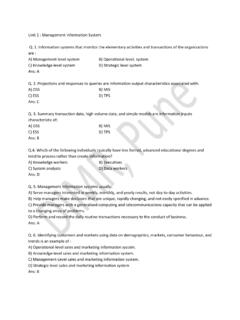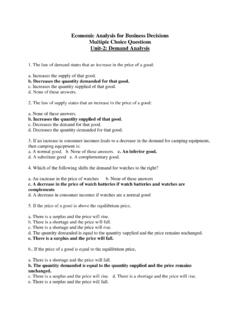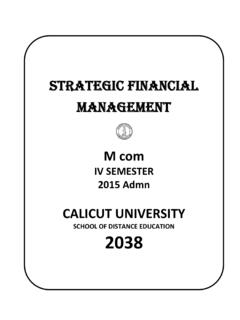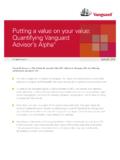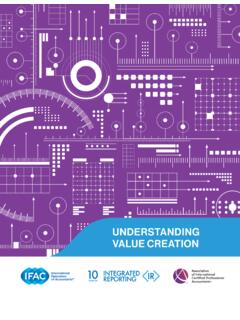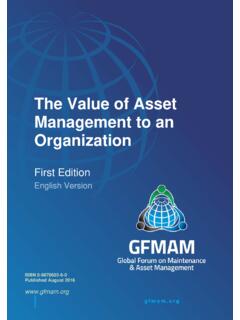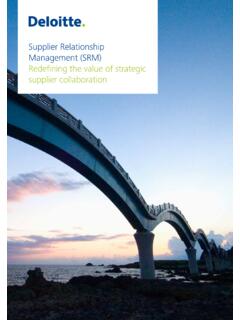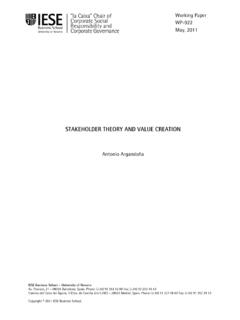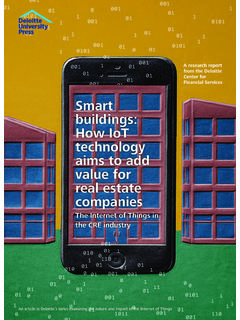Transcription of MCQ on Financial Management - DIMR
1 1 | P a g e MCQ on Financial Management 1. "Shareholder wealth" in a firm is represented by: a) the number of people employed in the firm. b) the book value of the firm's assets less the book value of its liabilities c) the amount of salary paid to its employees. d) the market price per share of the firm's common stock. 2. The long-run objective of Financial Management is to: a) maximize earnings per share. b) maximize the value of the firm's common stock. c) maximize return on investment. d) maximize market share. 3. What are the earnings per share (EPS) for a company that earned Rs. 100,000 last year in after-tax profits, has 200,000 common shares outstanding and Rs. million in retained earning at the year end? a) Rs. 100,000 b) Rs. c) Rs. d) Rs. 4. A(n) would be an example of a principal, while a(n) would be an example of an agent. a) shareholder; manager b) manager; owner c) accountant; bondholder d) shareholder; bondholder 2 | P a g e 5.
2 The market price of a share of common stock is determined by: a) the board of directors of the firm. b) the stock exchange on which the stock is listed. c) the president of the company. d) individuals buying and selling the stock. 6. The focal point of Financial Management in a firm is: a) the number and types of products or services provided by the firm. b) the minimization of the amount of taxes paid by the firm. c) the creation of value for shareholders. d) the dollars profits earned by the firm. 7. _____ of a firm refers to the composition of its long-term funds and its capital structure. a) Capitalisation b) Over-capitalisation c) Under-capitalisation d) Market capitalization 8. In the _____, the future value of all cash inflow at the end of time horizon at a particular rate of interest is calculated. a) Risk-free rate b) Compounding technique c) Discounting technique d) Risk Premium 3 | P a g e 9. _____ is the price at which the bond is traded in the stock exchange.
3 A) Redemption value b) Face value c) Market value d) Maturity value 10. _____ enhance the market value of shares and therefore equity capital is not free of cost. a) Face value b) Dividends c) Redemption value d) Book value 11. In _____ approach, the capital structure decision is relevant to the valuation of the firm. a) Net income b) Net operating income c) Traditional d) Miller and Modigliani 12. When _____ is greater than zero the project should be accepted. a) Internal rate of return b) Profitability index c) Net present value d) Modified internal rate of return 13. _____ is defined as the length of time required to recover the initial cash out-lay. a) Payback-period b) Inventory conversion period c) Discounted payback-period d) Budget period 4 | P a g e 14. _____ refers to the amount invested in various components of current assets. a) Temporary working capital b) Net working capital c) Gross working capital d) Permanent working capital 15.
4 _____ is the length of time between the firm s actual cash expenditure and its own cash receipt. a) Net operating cycle b) Cash conversion cycle c) Working capital cycle d) Gross operating cycle 16. _____ refers to a firm holding some cash to meet its routine expenses that are incurred in the ordinary course of business. a) Speculative motive b) Transaction motive c) Precautionary motive d) Compensating motive 17. _____ refers to the length of time allowed by a firm for its customers to make payment for their purchases. a) Holding period b) Pay-back period c) Average collection period d) Credit period 5 | P a g e 18. Amounts due from customers when goods are sold on credit are called _____. a) Trade balance b) Trade debits c) Trade discount d) Trade off 19. _____ and _____ are the two versions of goals of the Financial Management of the firm. a) Profit maximisation, Wealth maximization b) Production maximisation, Sales maximisation c) Sales maximisation, Profit maximization d) value maximisation, Wealth maximisation 20.
5 Consider the below mentioned statements: 1. A company is considered to be over-capitalised when its actual capitalisation is lower than the proper capitalisation as warranted by the earning capacity 2. Both over-capitalisation and under-capitalisation are detrimental to the interests of the society. State True or False: a) 1-True, 2-True b) 1-False, 2-True c) 1-False, 2-False d) 1-True, 2-False 21. Consider the below mentioned statements: 1. The dividends are not cumulative for equity shareholders, that is, they cannot be accumulated and distributed in the later years. 2. Dividends are taxable. State True or False: a) 1-True, 2-True b) 1-False, 2-True c) 1-False, 2-False d) 1-True, 2-False 6 | P a g e 22. _____ and_____ carry a fixed rate of interest and are to be paid off irrespective of the firm s revenues. a) Debentures, Dividends b) Debentures, Bonds c) Dividends, Bonds d) Dividends, Treasury notes 23.
6 Consider the below mentioned statements: 1. A debt-equity ratio of 2:1 indicates that for every 1 unit of equity, the company can raise 2 units of debt. 2. The cost of floating a debt is greater than the cost of floating an equity issue. State True or False: a) 1-True, 2-True b) 1-False, 2-True c) 1-False, 2-False d) 1-True, 2-False 24. Credit policy of every company is largely influenced by _____ and _____. a) Liquidity, accountability b) Liquidity, profitability c) Liability, profitability d) Liability, liquidity 25. XYZ is an oil based business company, which does not have adequate working capital. It fails to meet its current obligation, which leads to bankruptcy. Identify the type of decision involved to prevent risk of bankruptcy. a) Investment decision b) Dividend decision c) Liquidity decision d) Finance decision 7 | P a g e 26. The rate of interest offered by the fixed deposit scheme of a bank for 365 days and above is 12%.
7 What will be the status of Rs. 20000, after two years if it is invested at this point of time? a) Rs. 28032 b) Rs. 24048 c) Rs. 22056 d) Rs. 25088 27. How are earnings per share calculated? a) Use the income statement to determine earnings after taxes (net income) and divide by the previous period's earnings after taxes. Then subtract 1 from the previously calculated value . b) Use the income statement to determine earnings after taxes (net income) and divide by the number of common shares outstanding. c) Use the income statement to determine earnings after taxes (net income) and divide by the number of common and preferred shares outstanding. d) Use the income statement to determine earnings after taxes (net income) and divide by the forecasted period's earnings after taxes. Then subtract 1 from the previously calculated value 28. Which of the following would NOT improve the current ratio?
8 A) Borrow short term to finance additional fixed assets. b) Issue long-term debt to buy inventory. c) Sell common stock to reduce current liabilities. d) Sell fixed assets to reduce accounts payable. 8 | P a g e 29. The gross profit margin is unchanged, but the net profit margin declined over the same period. This could have happened if a) cost of goods sold increased relative to sales. b) sales increased relative to expenses. c) Govt. increased the tax rate. d) dividends were decreased. 30. Palo Alto Industries has a debt-to-equity ratio of compared with the industry average of This means that the company a) will not experience any difficulty with its creditors. b) has less liquidity than other firms in the industry. c) will be viewed as having high creditworthiness. d) has greater than average Financial risk when compared to other firms in its industry. 31. Kanji Company had sales last year of Rs.
9 265 million, including cash sales of Rs. 25 million. If its average collection period was 36 days, its ending accounts receivable balance is closest to . (Assume a 365-day year.) a) Rs. million b) Rs. million c) Rs. million d) Rs. million 32. A company can improve (lower) its debt-to-total assets ratio by doing which of the following? a) Borrow more. b) Shift short-term to long-term debt. c) Shift long-term to short-term debt. d) Sell common stock. 9 | P a g e 33. Which of the following statements (in general) is correct? a) A low receivables turnover is desirable. b) The lower the total debt-to-equity ratio, the lower the Financial risk for a firm. c) An increase in net profit margin with no change in sales or assets means a poor ROI. d) The higher the tax rate for a firm, the lower the interest coverage ratio. 34. Debt-to-total assets (D/TA) ratio is .4. What is its debt-to-equity (D/E) ratio?
10 A) .2 b) .6 c) .667 d) .333 35. A firm's operating cycle is equal to its inventory turnover in days (ITD) a) plus its receivable turnover in days (RTD). b) minus its RTD. c) plus its RTD minus its payable turnover in days (PTD). d) minus its RTD minus its PTD. 36. If the following are balance sheet changes: Rs. 5,005 decrease in accounts receivable Rs. 7,000 decrease in cash Rs. 12,012 decrease in notes payable Rs. 10,001 increase in accounts payable a "use" of funds would be the: a) Rs. 7,000 decrease in cash. b) Rs. 5,005 decrease in accounts receivable. c) Rs. 10,001 increase in accounts payable. d) Rs. 12,012 decrease in notes payable. 10 | P a g e 37. Uses of funds include a (an): a) decrease in cash. b) increase in any liability. c) increase in fixed assets. d) tax refund. 38. Which of the following would be included in a cash estimation/ budget? a) depreciation charges. b) dividends.



